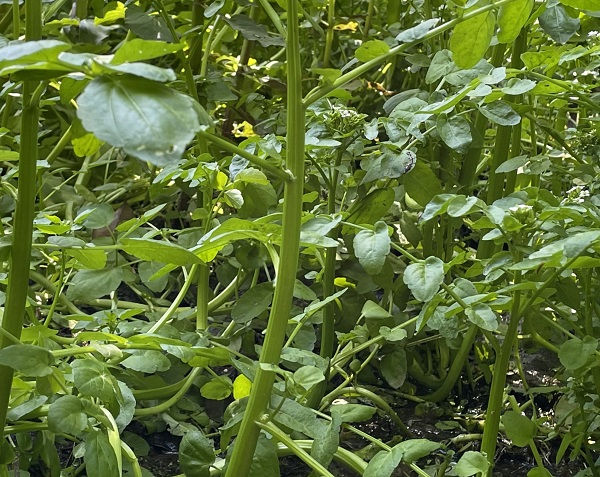
Edible plant - intermediate Season - late winter to autumn Common names Watercress, stream cress, brook cress, bank cress, tang tongues, teng tongues, carpenter's chips
Scientific name meaning: Nasturtium is derived from the Latin words Nasus and Tortus, meaning to wrinkle the nose. This is in reference to what the effect of the plant on the nasal passages. Officinale is Latin, and means an office, monastery or pharmacy. This is actually in reference to the type of place where medicines would have been kept. This is due to the plant's medicinal uses
Habitat  Found in wet places such as ponds, streams, rivers, springs and dykes. It prefers unpolluted water and is native to Britain. |
Overall structure  Forming dense mats of foliage across river and stream banks, or within the water itself. It can reach 60cm tall. |
Leaves  Watercress' leaves can be either erect or lying flat in the water. They are pinnately compound with pairs of oval shaped leaflets, that are sometimes bluntly toothed, and a larger terminal leaflet. When crushed, they smell strongly of watercress. The flower stem leaflets are much thinner and more lanceolate. |
Stem  The stem is hollow with sparsely spaced leaves and a circular cross-section. If the stem is submerged, it will produced several feeding roots along its length. |
Flowers  The flowers are white and have four petals. They appear in racemes from spring to autumn and are up to 4mm in diameter. |
Seeds  The tiny, spherical seeds form in long, thin seed pods. |
Possible lookalikes  Fool's watercress (Apium nodiflorum) and lesser water parsnip (Berula erecta), the leaves of both pictured next to watercress' leaf, are similar to watercress and grow in the same habitats. However, both smell of carrot/parsnip when crushed. Fool's watercress is edible, but lesser water parsnip is suspected to be poisonous.
|
Use as a food Watercress can be used raw (see hazards) or cooked Use in herbal medicine and medicine Rich in vitamins and minerals, watercress has been used for many medicinal purposes such as in respiratory, kidney, and skin disorders; to treat thinning hair and glandular tumours, and to treat tuberculosis.
If you are suffering from any ailment or need medical advice, please see your General Practitioner.
Hazards There is some evidence watercress may affect the metabolism of Paracetamol. It is a member of the mustard family.
In the UK, there is a waterborne sheep parasite called liver fluke that can affect humans. When harvesting from water, it is best to thoroughly cook any plant that is suspected of ever being below the water line in order to destroy any liver fluke that are present. Only plant material that has absolutely not been below the waterline or not had any possible contact with grazing animal faecal matter should be considered for eating uncooked
Other uses The juice has been used as a nicotine solvent Importance to other species The flowers provide a source of nectar for pollinators
Always stay safe when foraging. You need to be 100% sure of your identification, 100% sure that your foraged item is edible, and 100% sure that you are not allergic to it (it is good practice to always try a small amount of any new food you are consuming). If in doubt, leave it out!

Comments